In 2017, Peak Rail was operating the six-coupled side tank locomotive 'Jennifer', as I described in the post Peak Rail in 2017. It was raining hard on my journey to Rowsley on 28th June, where I was booked to drive 'Jennifer', and the rain seemed to intensify on my arrival. 'Jennifer' had been turned since my last visit, so that the chimney was at the north end, prompting the conclusion that we were going to couple at the north end of the train, with the 'top and tail' diesel at the south end. This was one of the suggestions made previously to investigate the 'surging' problem mentioned in the earlier post. The theory was that, with 'Jennifer' working uphill for most of the journey, the weight of the train would help to keep the couplings tight and reduce the 'surging'.
I was pleased that I'd have an opportunity to see if the theory was valid. Mike, who had driven the previous day with the 'new configuration' was fireman and he had steam raising well in hand. I was pretty wet by the time I'd oiled round but I endeavoured not to complain too much. We'd a two hour driving experience before the service train which concluded with the trainee shunting around the loop to couple onto the north end of the train.
Although my principal interest is 'steel wheels on steel rails', all forms of engineering fascinate me so I was intrigued to see that a coach had been reserved for the 'SUNBEAM TALBOT DARRAQ REGISTER' and, within minutes, a stream of vintage cars started to arrive.
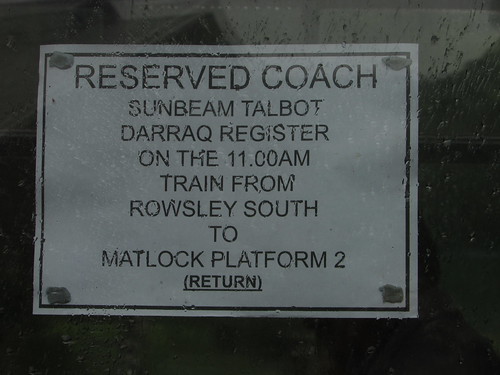
This sign in the rain-splattered coach window (with a missing 'C') alerted me to the arrival of the vintage cars.
The rain had eased somewhat and I managed to take pictures of some of the vehicles but I'd only a few minutes before the train departed, with 'Jennifer' at the tail end. There's a website describing the Sunbeam Talbot Darracq Register vintage car club here.
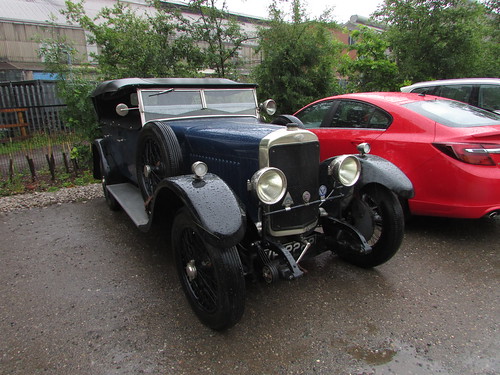
'Sunbeam' produced high-quality motor vehicles ...
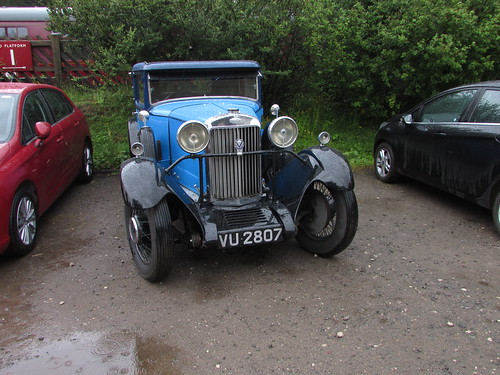
... in a range of styles.
The famous 'Sunbeam' cars were built in Wolverhampton where both my parents originated and where I lived or worked for many years. But the real connection is that my grandfather was Chief Jig and Tool Designer at Sunbeam, three of my uncles had engineering posts there for a time and my mother had a spell as a secretary there. 'Sunbeam' were closely associated with motor racing and, when I was young, my grandfather would proudly discourse on his involvement in the building of the 1,000 h.p. car in which Henry Segrave exceeded 200 m.p.h. for the first time in 1927 at Daytona Beach. Sadly, by the time I was old enough to have a proper understanding, my grandfather had passed away but he had enthused me with a lifelong interest in engineering. The car club have a page on Henry Segrave's exploits here, with a link to a video.
As I expected, with the 'Peak' hauling the train, we experienced some 'surging' on the way to Matlock. At Matlock, we collected the Train Staff from the diesel ready for the return journey. When we received the 'Right Away' from the Guard, I was surprised at how readily we moved away, until I realised that the line from the platform to Matlock Riverside is downhill (at around 1 in 170) and the uphill climb only starts beyond Bridge 26, the Derwent Bridge.
 Gradient Diagram Ambergate - Bakewell
Gradient Diagram Ambergate - Bakewell
Braking was needed to reduce speed for the long-standing 5 m.p.h. restriction through Matlock Riverside, then I put on steam for the climb at around 1 in 400 to Darley Dale. Even with around 300 tons on the drawbar, this was not very taxing. Most importantly, the 'surging' effect appeared considerably attenuated.
I found that stopping accurately was proving more difficult. Like many industrials in preservation, a vacuum brake system has been added to an engine which originally had only steam- and hand-braking. A British Railways pattern combination steam brake had been fitted to the engine so that, as vacuum is reduced in the train pipe to brake the train, the steam brake should apply proportionately to brake the locomotive. Unfortunately, the application of the steam brake applied this way I found rather harsh. A British Railways pattern application valve mounted right in the front corner of the cab I found hard to reach, since I'm not very tall, and having grasped it, my visibility outside was impaired.
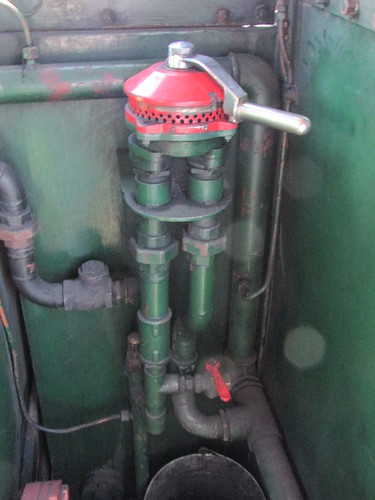
Locomotive 'Jennifer': British Railways pattern Driver's Vacuum Brake Application Valve with reservoir release cock (red handle) below.
The stop at Darley Dale wasn't too bad but at Rowsley, I overran a few feet, making it difficult to take water from the Grey Tank Wagon. In any case, a badly-fitting delivery hose meant that, even when stopped correctly, everybody within about twenty feet received a good soaking.
On the second return trip, I used a little more power and we judged the 'surging' to be further attenuated, until steam was turned off during braking when 'bumping' resumed. I was still having trouble with the braking, overrunning a little more than the first time, necessitating getting permission from the Guard to set the train back before we could replenish the tank.
At this point, Mike was relieved for the rest of the day by Chris W.
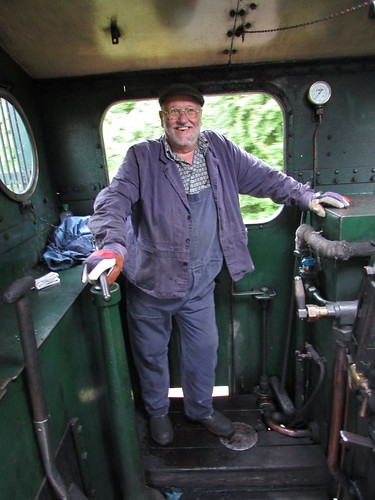
Chris Ward on the footplate of 'Jennifer'.
The third return trip went well and I stopped correctly for water at Rowsley. However, having used only around one third of a tank, Chris and I agreed to make the fourth trip before watering.

A thoughtful Jan keeping a lookout as the 'Peak' completes the journey to Matlock Town.
The fourth trip was uneventful and we filled with water again for the last time that day and Chris and I enjoyed the fifth and last trip. Even the weather was improving! Our conclusion was that comfort, if not perfect, was at least much improved operating with 'Jennifer' at the north end of the stock.
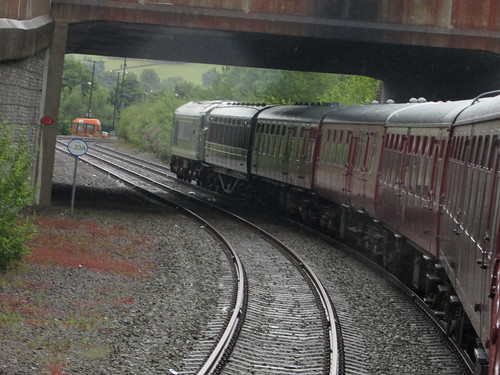 Cars and trains at Peak Rail: View from 'Jennifer' trailing as the 'Peak' approaches Matlock Town.
Cars and trains at Peak Rail: View from 'Jennifer' trailing as the 'Peak' approaches Matlock Town.
Related posts on this website
To see all my posts about Peak Rail, select Label 'Peak Rail' or click here.
My photograph albums
Cars and Trains at Peak Rail.
'Jennifer'.
All my Peak Rail albums.
